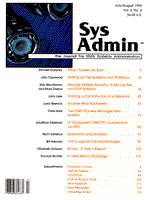Sidebar: Many versus Few Partitions
Is there a "better" choice among partitioning
schemes? Should
you use only two or three partitions on a disk? Should
you use five,
six, or maybe all seven partitions?
Advantages of Using Fewer, Larger Partitions
There is less wasted space. When you create a file system
on a disk, you prevent a file from growing across the
partition boundary.
You might have a gigabyte free in the next partition,
but you can't
use it when one partition fills up until you symlink
or change your
mount points.
Your vfstab (fstab) is smaller and simpler.
Restoring files after a disk crash is easier.
Backup scripts can be simpler.
Advantages of Using Many, Smaller Partitions
Smaller partitions act as firewalls against runaway
processes.
Selected partitions can be mounted read-only for security.
You can tune the quantity of inodes and fragments per
block separately by partition.
OS upgrades can be simplified if local software is kept
separate from vendor software.
You can load-balance across multiple disks, by putting
the most heavily used directories on different disks.
Partitions act as security firewalls when used with
anonymous ftp and tftp.
More partitions give you more options for disk crash
recovery and more options in dump scheduling.
Restores of individual files from backup tapes are faster,
because you're searching through smaller dump images.
This is significant
because recovery of accidentally deleted files occurs
more frequently
than recovery from crashed disks.
|
